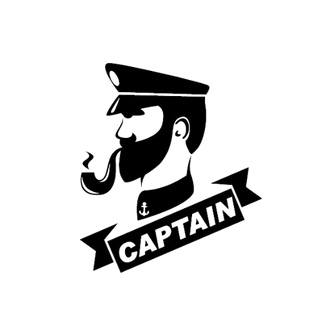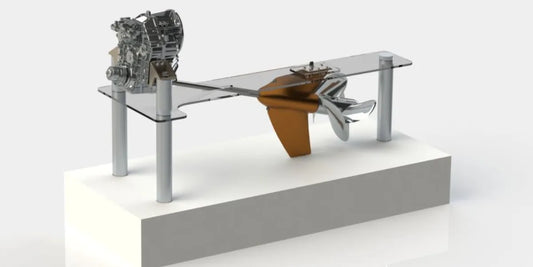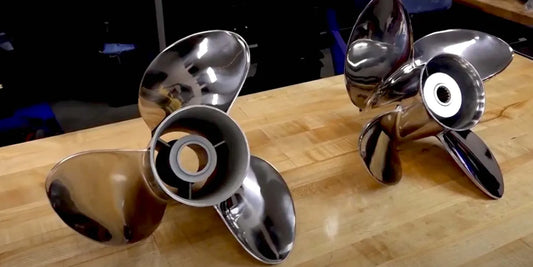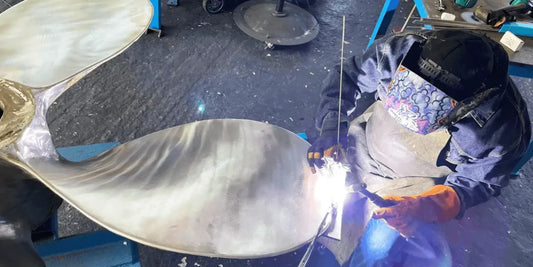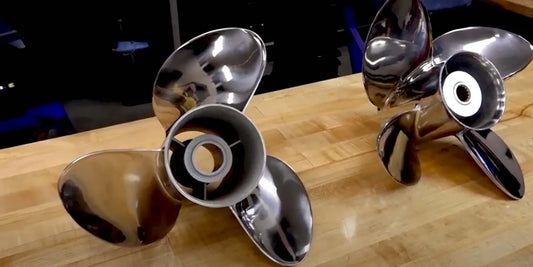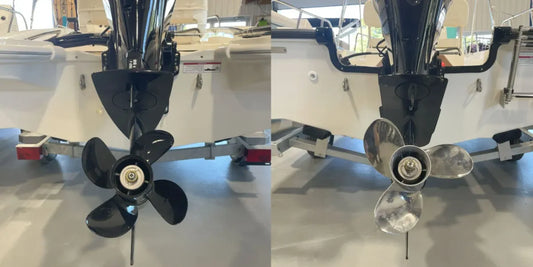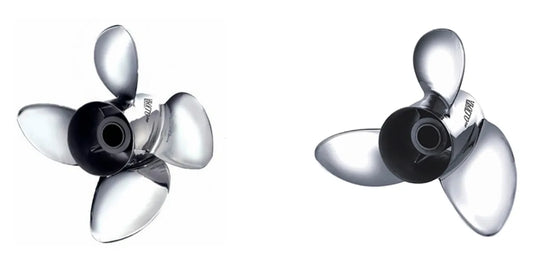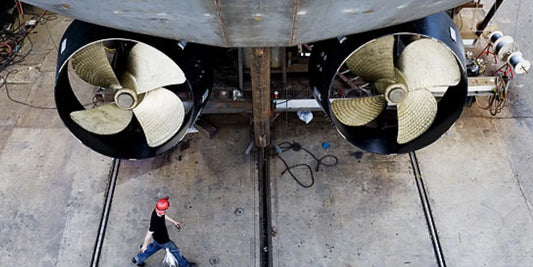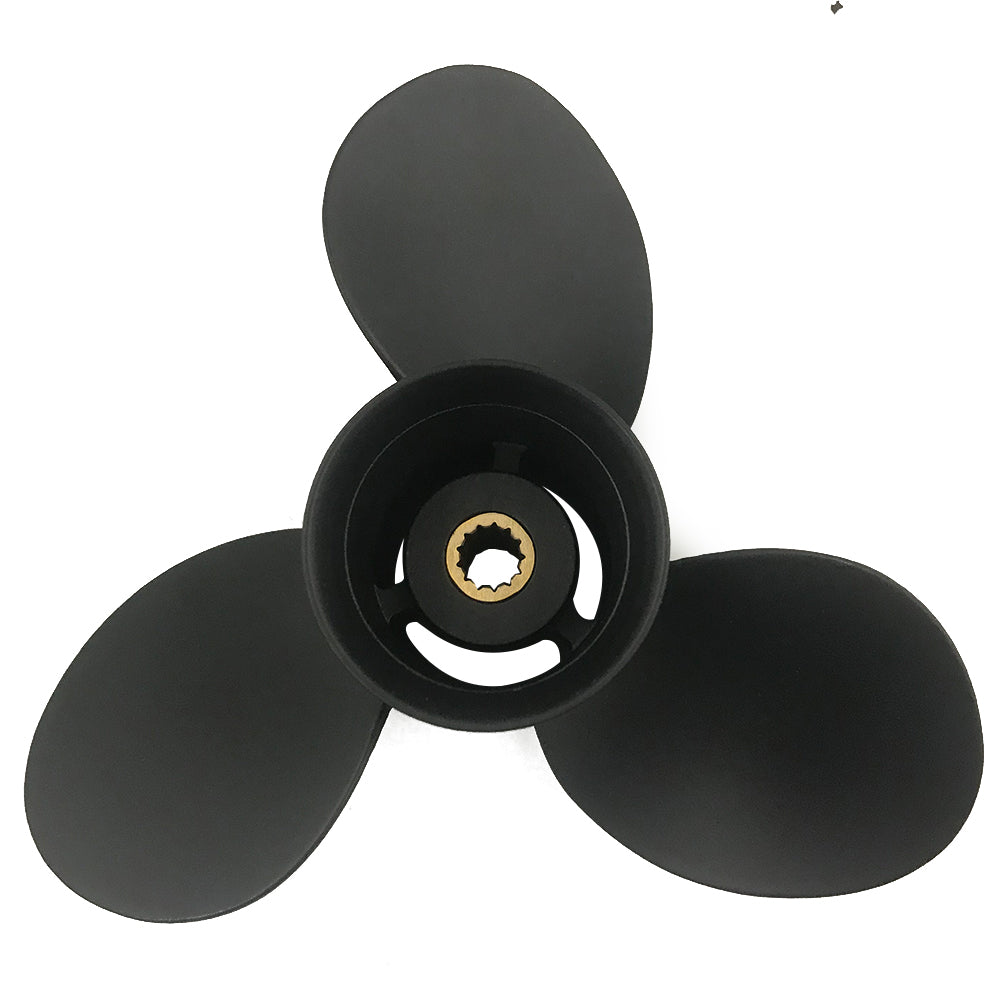Choosing the right boat propeller is crucial if you want to enjoy your marine adventures fully. However, this can be quite an experience when you try it online. With so many options and technical specifications, you would be hard-pressed to decide which one to pick for your outboard or inboard setup. That is where our guide steps in. Whether you are looking to improve performance or fuel efficiency, or simply want to replace your old prop, this article will guide you through the best tips for buying online in 2025. We will help you become familiar with what to look out for and how to identify trustworthy sellers, so you can make your choices with complete confidence and inform your decisions every step of the way, keeping your boat running smoothly. Let the journey begin as we reveal secrets to unlocking the best boat props for sale online!
Understanding Boat Propellers

What Does A Boat Propeller Do?
A boat propeller is essentially a device with blades that rotate to propel the boat through water. It gives thrust on rotation to push the watercraft either forward or backward and the rotating energy is supplied from an engine of the boat. Made from aluminum, stainless steel, or composite, propellers are available in an infinite variety of sizes and configurations tailored for specific engine types and boating activities. The performance of a boat-propeller would rely in pitch, diameter, speed, fuel economy, and handling, in addition to the number of blades. To provide it with the best-performing and most reliable propeller, it must also ensure the engine's longer life.
Propeller Types: Outboard Vs. Inboard
Floating nearby and conversing with American-style potato chips, interviewed their owners and developers, and those reviews controlled the language available to the outside press. Now, a few times were offered at the Aluminum Factory.
The major distinguishing feature that sets outboard propellers apart is their design, ultimate application, fabrication, and performance. Outboard propellers are best suited for outboard motors that hang off the stern of the boat. Outboard propellers are used in smaller boats, fishing vessels, and recreational crafts, making maintenance easy and lightweight enough to carry. They are typically 2-3-4-bladed propellers, made of aluminum and stainless steel, designed to meet specific performance criteria.
On the other hand, inboard propellers are connected to motors located inside the hull of the boat. Their configuration is more complicated, involving the driveshaft for the rudder and steering. They are designed to provide large amounts of power and torque, making them apt for larger machinery such as yachts, commercial vessels, and performance boats. Inboard propellers typically have a larger diameter and are tuned for efficient power delivery, especially under heavy loading conditions. They are generally composed of durable materials, such as bronze or stainless steel.
Inboard propulsion provides steady and strong thrust when power is needed for rippling water conditions, while outboards offer easy maneuverability and are easily changed. Choosing one depends on what the boat intends to do, its size, and the layout of the engine. Each has its advantages in answering various boating needs.
Key Features to Consider for Your Prop
When selecting a propeller, the buyer should consider key factors to achieve optimal performance and efficiency for their boat. Material comes first. Aluminum props are lightweight and cost-effective, whereas stainless steel is more durable for heavy-duty work and better-performing under severe conditions. Second, the pitch should be set in reference to engine specifications, which in turn should not cause any strain on the engine and maximize its efficiency of use.
Next comes blade design. With the blade designs, you could go for three blades that provide greater speed or four and five blades that have better handling capabilities and produce more thrust at lower speeds. Additionally, the larger the prop diameter, the more it would suit heavy boats, whereas smaller diameter props are better suited for faster and lighter vessels.
Finally, factor in special features like variable pitch or interchangeable hub systems, so that the propeller will continue to adapt and perform under varying boating conditions. Focus on such attributes to find the best prop for the unique needs of your boat.
Finding the Right Boat Props for Sale

Where to Shop for Boat Propellers Online
When searching online for boat propellers, it is crucial to visit a reputable retailer specializing in marine equipment. Dedicated suppliers of boating equipment typically maintain a larger inventory of propellers for various engines and types of boats. Some of the popular marine equipment online stores usually offer detailed descriptions of the products, their specifications, and even customer reviews, providing a truly well-guided shopping experience on comparing various options.
Additionally, manufacturers' websites are very valuable, as they are on the cutting edge of new models and technologies, and they include warranty information and service options, allowing manufacturers within the industry to assist with warranty or service issues. In some cases, the platforms even have software to pair your boat and engine with compatible props, thus easing your search. The online solutions are ideal for those seeking affordability and a certain level of quality, with seller ratings and buyer protections ensuring safe transactions and access to a wider range of products.
Evaluating the Best Brands: Solas, Michigan Wheel, and More
For the boat propeller business, when it comes to buying a quality one, reputed brands such as Solas and Michigan Wheel usually top the market, focusing on design and construction after performance and durability. Solas are renowned for their precision engineering and boast one of the largest selections of stainless steel and aluminum cast propellers, catering to the diverse needs of the boating community. They are highly praised for the great fuel economy and smooth acceleration of their boats. Michigan Wheel, on the other hand, has earned its reputation over the past hundred years; a reliable propeller appreciated for its ingenious design and durability, especially in heavy marine use.
Together with the industry toppers, Mercury and Quicksilver remain iconic brands. Their offerings extend to a variety of uses, ranging from recreational boats to professional marine operations. These brands offer advanced solutions, improved hydrodynamics, and corrosion-resistant materials, among other benefits, which result in enhanced performance and longer life. Comparing the various IRs of pitch, diameter, and blade technology enables the boater to find the most suitable option for their particular engine and water conditions. An investment in a quality brand propeller will ensure performance and reliability for many years, making the process of researching and choosing well worth the time.
OEM Vs Aftermarket Options
Deciding between OEM and aftermarket propellers requires careful consideration of differences in quality, compatibility, and cost. The original manufacturer of the propeller engine company manufactures OEM propellers. So they perfectly fit there as intended; therefore, they are guaranteed to perform. Frequently, the preferred option is one considered reliable and manufactured to specification. In contrast, aftermarket propellers are manufactured by third-party companies, present a cheap alternative, and can come in various designs and materials.
Aftermarket options are sometimes able to access and add innovative features for particular applications to an OEM propeller but risk compatibility if ill-matched to the engine. Such reviews and experiences have sometimes highlighted differences between the two in terms of durability, thrust efficiency, and speed optimization. Boaters should consider cost, their performance requirements, and the ability to obtain warranty coverage in deciding which type of propeller to select. The right choice, after considering these aspects, will be able to provide sufficient power and efficiency in the water.
Tips for Selecting the Perfect Propeller

Choosing Between Stainless Steel and Aluminum Props
When choosing between stainless steel and aluminum propellers, one must consider both performance and practicality. Stainless steel propellers are more resilient and long-lasting, thus suitable for high-performance applications or vessels that operate at higher speeds. On the other hand, since stainless steel props unfold their high precision to enable better adherence to shape under load, preventing deformation through utmost pressure, it grants good fuel efficiency. Hence, their price is high, and for casual boating, it might be overkill.
They are propellers traditionally considered inferior to stainless steel, yet aluminum propellers are practically affordable, lightweight, and great for recreational boating or those who have somewhat limited expenditures. Aluminum propellers provide excellent value, as they are easy to repair and replace if necessary. While aluminum propellers may not possess the same strength or efficiency as stainless steel, advancements in manufacturing over the years have significantly improved their overall performance and dependability. Thus, when making the best choice, considering factors such as water depth, the frequency of boat usage, engine size, and environmental conditions will be important. By weighing these, you shall be assured of maximum performance and value for your kind of boating.
Factors Affecting the Performance of Propellers
Material: The material used in propeller construction affects its durability and efficiency to varying degrees. Aluminum propellers have the silver lining of being lightweight and reasonably financially viable. Stainless steel ones are the ones to choose if you want higher strength and better resistance to damage associated with harsher environments. Among 21st-century materials, composites are slowly gaining popularity due to their affordability and moderately acceptable durability.
Propeller Size: The diameter and pitch of a propeller have a distinct bearing on its performance. A larger diameter tends to function better for heavier boats in terms of thrust; conversely, the pitch, that is, the distance the propeller moves forward in a single rotation, influences acceleration and top speed. Propellers with higher pitch are suitable for higher speeds, whereas those with lower pitch allow for better maneuvering and a quicker takeoff.
Number of Blades: As the task of force generation, the propeller ensures various features are offered, such as speed, fuel consumption, and low vibrations, among others. There are mostly three-blade propellers, balanced between speed and efficiency, with four- and five-blade varieties offering a softer operation and more thrust at lower speeds.
Engine Power and Boat Type: The propeller must be matched to the engine it is working with to ensure optimal performance. Often, high-powered engines require special propellers that can withstand stronger forces. In addition to engine considerations, the type of boat in the decision process is also essential: whether it is a fishing boat, a pontoon, or a high-speed craft. The propeller must be selected with its actual purpose in mind.
Water Conditions: Depending on the factors involved—water conditions, depth, and salinity —the propeller may be significantly affected in its operation. One could look out for propellers that resist damage while in shallow waters full of debris. In contrast, those navigated in open sea saltwater areas may be made of very high corrosion-resistant materials.
Direction of Rotation: The rotation of the propeller-air clockwise or anticlockwise often occurs due to the engine setup and the resultant handling changes of the vessel. Such vessels with twin propeller systems have their blades rotated in opposite directions to give balance and good maneuvering.
Hence, matching the right propeller against each particular condition ensures great performance enhancement, efficiency, and longevity. Associating with professionals and referring to trusted sources for the selection would provide a better choice catered to your needs.
With V6 and Volvo Penta recommendations
When it comes to V6s and Volvo Penta systems, the focus should be on engineering and compatibility features. V6 engines are considered to be engines that have struck a great balance between power and efficiency, making them suitable for marine applications. The V6 can accelerate from 0 to 60 in 3 seconds, offering smooth operation while being fuel-efficient and providing immense torque for handling heavy loads.
Conversely, Volvo Penta offers complete solutions that include innovative propulsion systems and intelligent controls. It is a matter of testing their recommendations to ensure the systems run flawlessly in various conditions; Electronic Vessel Control (EVC) serves as an important feature, providing ease of use while maintaining precision and robustness.
The strength of V6 engines fused with the transformer power of Volvo Penta companies make for a high-performing, efficient, and flexible setup. Typical specifications from these manufacturers accentuate durability, sustainability, and fuel economy optimization so that these systems weigh in equally on performance and ecological considerations.
Popular Boat Propeller Models of 2025

Exploring the Benefits of Yamaha and Mercury Bravo Props
Yawning and Mercury Bravo propellers in 2025 were leaders and remain so in the marine marketplace, delivering top-grade performance, durability, and versatility for various marine activities. Yamaha propellers stand distinguished for their unique designs, offering smooth acceleration, better fuel economy, and excellent handling on all water types. The construction materials considered for making these propellers included stainless steel and aluminum, which provided longevity against corrosion and wear, thus making them suitable for both freshwater and saltwater environments.
In contrast, Mercury Bravo props are designed to suit performance-styled boats and heavy-duty applications. Their pitch and blade can be customized to perfectly match the vessel-specific requirements of speed, stability, and cornering. And since the Mercury Bravo propellers always have the requisite thrust and help mitigate cavitation even in the harshest of operating conditions, they continue to be trusted by most people. Both Yamaha and Mercury stand for innovation, thereby ensuring the realization of propeller models that serve the modern boater who values efficiency, performance, and durability.
Why Quicksilver and Apollo Propellers?
Quicksilver and Apollo propellers are renowned for advanced engineering, versatility, and quality consciousness. The Quicksilver propellers are manufacturing-precision-oriented, made from sturdy materials such as stainless steel or aluminum to ensure performance and longevity. Quicksilver propellers, in their multiple designs, tailor to different boat applications, be it for speed, fuel efficiency, or load-carrying ability. Their versatility binds industries together for the recreational and professional gasoline-powered crafts.
On the other hand, Apollo propellers are synonymous with superlative cutting-edge technology and hydrodynamic designs. These propellers produce a thrust force to counteract weight and drag forces while the thrust force on the vessel is maximized and speed and fuel efficiency are at their optimum levels. Innovative design by Apollo includes features such as interchangeable hub systems, increasing adaptability to be used with different types of engines. For utmost durability and top-notch performance, an Apollo propeller is indeed a reliable solution in both fresh and saltwater areas. Thus, Quicksilver and Apollo propellers ensure onboard comfort through advanced technology and innovative thinking.
Technological Innovations in Propellers: Enertia Eco and Tempest
This is a propeller which is said to be revolutionary as far as fuel economy is concerned and was designed to satisfy the requirements of environmentally conscious boaters. While its new design reduces drag and increases lift, it also optimizes fuel consumption so that the boat gains better mileage without compromising performance. Made from a high-quality stainless steel alloy, the Enertia Eco propeller offers durability and dependability, along with the ability to operate effectively under arduous conditions. From the blend in its blade geometry, you can get more speed at a lower RPM allowing for less stress on the engine and reduced operating costs.
The Tempest propeller, on the other hand, focuses on power and handling for bigger boats, especially those equipped with high-performance engines. The aggressive blade design enhances acceleration and top speed, making it popular among tournament anglers and water sports practitioners. In addition, the rake and cup of the Atlantic Prop provide excellent grip down in water, so that it can produce consistent results under rough conditions. This mix of features offers incredible speed, accuracy, and control.
Together, the Enertia Eco and Tempest speak volumes about propeller technology innovations, which answer both environmental issues and high-performance demands on the water. These advances demonstrate how modern engineering continues to enhance the entire boating experience to meet various needs and desires.
Maintenance and Care for Your Boat Props

How to Maintain Your Outboard Propeller
To keep my outboard propeller well maintained, I emphasize regular inspections and cleaning for any damage or debris. After every trip, I check the propeller for any fishing lines, ropes, or other entanglements that could bind the shaft or shearing its performance. Should I find any nicks, dents, or cracks on the blades, I am quick to get them fixed-in even minor scratches lead to loss in efficiency or speed. Monthly removal of the propeller allows me to inspect the shaft and apply waterproof marine grease if necessary, thereby preventing corrosion.
Regular cleaning is necessary since aquatic plants, barnacles, or dirt can attach themselves to a prop, resulting in less efficient functioning. I give it a light scrub with a soft brush and some mild detergent, making sure the propeller has a smooth finish following that. Another thing to keep track of is the propeller's hardware. Make sure everything is tightened instead of overly tightened (nuts, washers), and replace them if necessary to offer protection during operation: thrust washers in particular when worn out.
Proper storage is just as important for my propeller when not in use. Once the prop is removed for storage or maintenance, it is stowed away in a dry and safe place to prevent rusting or accidental damage. Additionally, I ensure that it is balanced and aligned, either by myself or professionally, so that it doesn't vibrate when in use. Following these steps helps me prolong the life of my outboard prop and guarantee a smooth and efficient boating experience.
Signs You Need to Replace Your Boat Prop
Here's one sign I notice when my boat's performance feels like it's decreasing in other aspects, such as with reduced acceleration, lower top speed, and higher fuel consumption. And this I know usually happens when my propeller gets damaged, bent, or has worn-out blades, in some way disturbing the flow of water through it, which reduces its efficiency. Another sign is when the vibrations get made abnormal during operation. This may indicate that the propeller is out of balance or has sustained significant damage. This worsening surely will spoil my boating experience and in the long run can wear down my engine.
Another warning is to look for visible damage, such as cracks and dents, in the blades; they will impair the propeller's ability to propel effectively. Also, if I find it getting difficult to reach the RPM (Revolutions Per Minute) appropriate for my engine, that may well be a further signal that the propeller has changed, or it is no longer the right choice for the boat or has exceeded its working life. At this time, corrosion from the prolonged action of saltwater or debris strikes may affect the strength of a propeller, necessitating its replacement to ensure safe and smooth operation.
The last thing I do is observe as much as I can about how the boat handles while underway. For instance, if the steering feels heavy or if the boat is unstable at certain speeds, the propeller probably has a defect or is not operating properly. I have learned that being proactive with such warning signs will make boating very enjoyable for me and prevent further damage to my engine, protect my life on the water. Keep my boat running well with regular maintenance and timely replacement.
Tips for Storing and Protecting Your Propeller
Any good service checklist for a marine propeller includes the correct storage of the piece and protection of the prop to maintain proper operating parameters over time. Cleaning the propeller is one of the first steps I take for proper storage, as it needs to be brought to storage free from residue, salt, or debris. If such materials are left unattended, they can be potential causes of corrosion and wear. Perhaps a little soap and water will do the trick, but for tougher grime, I sometimes use a specialized marine cleaning product. Drying the propeller thoroughly is the last step in cleaning to prevent moisture damage during storage.
For storage, I ensure that the propeller is kept in a dry, cool environment, sorting away direct sunlight and extreme temperatures. UV rays or excessive heat may accelerate any weakening that the materials undergo, particularly in composite or aluminum propellers. Some further packaging is done to protect the sustenance; I either put on a propeller cover or tightly wrap it in a soft material that provides protection. This protects the blade against accidental scratching or damage, especially when stored with other tools or equipment.
Lastly, I conduct a few random inspections of the propeller while it is in storage, looking for potential signs of rust, cracking, or pitting. Any peculiarities that I may detect are addressed immediately to prevent small repairs from becoming big ones. If I am proactive and stay on top of cleaning, storage, and inspections, my propeller remains with me for a much longer time, making smooth and hassle-free boating experiences ever so easy.
Reference Sources
-
Selecting the Best Prop is Crucial but Easy with Mercury - Offers a Prop Selector tool to help choose the best prop based on boat type and engine info.
-
How to Find the Right Boat Propeller - Guides on selecting propellers by considering engine RPM, hull type, and performance goals.
-
Select the Best Propeller for Top Boat Performance - Discusses key factors such as material, blade number, and size for optimal boat performance.
-
Choosing a Propeller - Focuses on pitch, diameter, and blade shape, as well as material options such as aluminum.
-
BBLADES Propellers - A professional service for custom propellers, lab finishing, and blueprinting in the U.S.
Frequently Asked Questions (FAQs)
What are some advantages of using steel propellers for outboard boats?
Compared to their aluminum counterparts, steel propellers can boast of better strength and durability. They also help enhance boat performance, offering improved fuel efficiency and top-end speed. Moreover, stainless steel props are less prone to damage and cavitation, which is why many watermen favor them. Powertech and Michigan Wheel are among the brands that offer quality stainless steel propellers for different boating requirements. Hence, investing in a stainless steel outboard will surely enhance your boating experience, especially when engaging in various water sports activities.
How do I select a propeller for my boat's engine?
Selecting the right prop involves factors such as size and pitch, as well as the horsepower class. For instance, an aluminum 3-blade prop might run better with outboards at lower horsepower, whilst a 4-blade stainless steel prop could be the one if high performance is a requirement. Therefore, the type of prop must be in accordance with your engine through a range of 90-300 hp or 40-140 hp. You can also ask retailers and manufacturers, such as Quicksilver and Mercury Bravo, which provide OEM recommendations tailored to the style of your boat and its intended use.
What are the differences between a 3-blade and a 4-blade propeller?
Concerning performance and handling characteristics, there exists some difference. A 3-blade propeller typically provides better top-end speed, while a 4-blade propeller offers improved quick launches and acceleration, making it suitable for a wide range of water sports. If you need your boat to be able to start quickly and be steady, a 4-blade will do wonders for your performance; having said that, if you are aiming for speed and nothing else, then a3 3-blade will do well. Apollo Propellers and Ballistic Propellers are some of the companies that make both styles to cater for different applications of boating.
Are there specific outboard and sterndrive propellers for sale?
Yes, there are specialized propellers for both outboard and sterndrive systems. These propellers are designed to achieve optimal performance tailored to the engine and specific use case. For instance, the Bravo series has been popular with sterndrive applications. Meanwhile, outboard boat propellers are categorized by material, ranging from stainless steel to aluminum. In your search for prop finishers and similar products, you may want to consider the Flo-Torq II hub kit to maintain proper balance in your boat. Each type is also capable of fulfilling specific applications in their intended manner. Hence, you must get a propeller suited to your boating style.
What things shall I keep in mind when buying a new propeller for my boat?
When selecting a new propeller, consider four key factors: material, size, pitch, and blade design. Stainless steel propellers are considered stronger and more efficient, whereas aluminum propellers are lighter and less expensive. You will also want to check if the propeller is the right fit for your boat engine specifications, for example, the spline and hub system. Further performance enhancements include cup design and blade geometry. Yamaha and Powertech are among the brands offering options tailored with particular differences in horsepower and performance.
How does a different propeller improve boat performance?
Changing your propeller is an essential factor involved in enhancing all aspects of performance of the boat, such as speed, acceleration, and fuel efficiency. Therefore, a higher pitch or four-blade prop-swapping would produce maximum hole shot and stability in rough water conditions. Also, consider props from high-grade brands like Michigan Match or Acme; the design of their props is heavily inclined towards enhancing the performance of the putter medium with respect to the rated horsepower of the boat engine. Periodically analyzing the prop performance and physical condition will maintain the factors to consider for date purposes so that you never lose out on quality enjoyment on the water.
